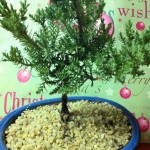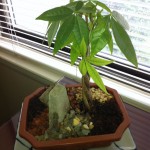My first bonsai was a Christmas gift juniper from my husband’s relatives. I would love to switch out my current blue ceramic pot (pictured below) with a 5.5 in-6 in The Intelligent Plant Light/Timely Lighting Care pot. Following a re-decoration similar to my friend’s potted plant (also pictured below). I prefer a traditional ceramic bonsai pot but don’t have too much choice as I’m depending on my The Intelligent Plant Light machine. I really don’t have a green thumb =( so I hope that my bonsai has a better chance because of it…..
It’s been about a year since the plant was given to me and unfortunately it’s currently not doing that well. This is probably due to under-watering or disease. I’ve also read from various sources that junipers don’t fare well indoors since they are meant to be an outdoor plant. Do not buy a juniper unless you will eventually transfer it outside; you’ll only be heart-broken. I may re-try my hand at bonsai-caring with a fairly tolerant braided bamboo a.k.a. good luck tree (which is what my friend has).
The materials you will need to re-create something similar to my friend’s braided bamboo bonsai environment or to make your own beginner’s kit includes:
bonsai humidity/drip tray pebbles: It is a good idea to add water to your bonsai humidity/drip tray and to raise your bonsai pot out of the water by lining your tray with river pebbles.
decorative crushed shale landscape rocks: A decorative dressing which doubles as a soil mix.
decorative landscape pebbles, small grade size: Clear-coated, tumbled smooth, and non-toxic.
professional bonsai soil, granular form: Considered sterile and environmentally inert. It is a natural non-toxic, highly absorptive ceramic granule with a generally neutral PH. Approximately 25% water, 25% air, and 50% solid particulate matter. It is dimensionally stable and will not degrade like other amending products. There is no need for it to be re-applied year after year.
Akadama brown soil: Can be mixed with other bonsai soils or used by itself. It is a flash-fired, soft, volcanic clay.
Kyoto moss spores: These moss seed spores produce a beautiful, bright green velvety moss of the variety commonly found in the famous Kyoto gardens of Japan.
Colorado rock granules (tree soil additive): Is a naturally occurring volcanic cinder that has a porous structure which makes the material lightweight and highly moisture retentive. Incorporate into your bonsai soil mix to increase drainage (aeration). It will absorb up to 40% of its weight in water.
Bonsai Pro Brand fertilizer: It does not cause undesirable salt buildup in your growing medium. It is a professional formulation containing all essential macro and micro nutrient minerals for healthy bonsai. With bonsai pro you feed your bonsai with each watering.
bonsai training wire
drip tray
traditional beginner bonsai shears: You probably would not need the more advanced tools until your tree matures.
*Other great advice from bonsai expert, Nancy Cyburban of Life’s Little Amusements regarding my personal bonsai project:
- If you use your own garden rocks, it’s very important to boil the rocks in order to kill any bacteria or parasites that could be transferred from your garden soil; also true of any beach sand or gravel you purchase.
- If you use moss from your garden (1″-2” square): Place in a blender with some yogurt or milk and make a broth then paint it on the area you want the moss to grow on and water. Alternately if you find a large enough patch of moss, it is easy to transplant moss as it just peels up and you just press it down where you want it. Be sure to keep it moist by misting even if the plant does not need water until the moss acclimates.
- To make your own fertilizer, use any balanced plant fertilizer meant for evergreens but do buy the kind you mix with water. MIX HALF STRENGTH only. When you find a good book you can obtain further directions.
Nancy Cyburban suggested these two great bonsai beginner books:
- Bonsai Workshop- Styling and Training by Herb L. Gustafson. This book is for the beginner to intermediate bonsai enthusiast; it outlines the essentials of the care, creation, and display of bonsai trees. This book is said to be “the only one you need.”
- Bonsai Basics by Christian Pessey and Remy Samson which is a
popular beginner book. It contains easy-to-follow training techniques for pruning and wiring and expert advice on repotting, watering, and feeding with over 200 color photographs and numerous line drawings.
I personally own The Living Art of Bonsai by Amy Liang, which was the second part of my Christmas gift. I highly recommend it to any bonsai enthusiast. I’m paying it forward and hope this blog post is of some help.
*Reference: Thanks to Ms. Nancy Cyburban of Life’s Little Amusements for her kindness, patience, and invaluable wealth of information.
*Photocredit: NYCupcake via iPhone
















